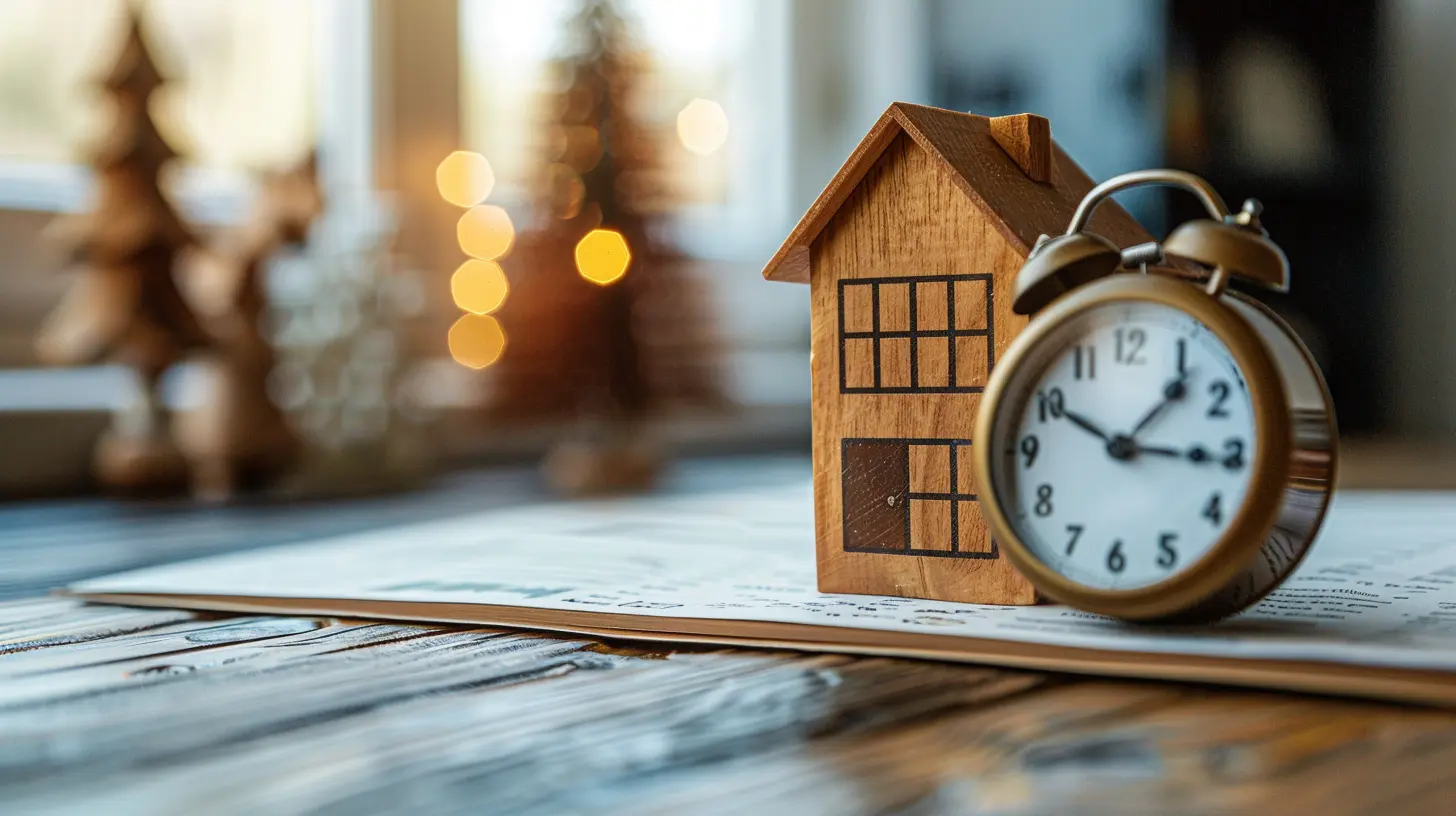How to Plan Your Home Purchase Timeline
5 November 2025
Buying a home isn’t just about picking the perfect house and putting in an offer. It’s a journey—one filled with twists, turns, and unexpected detours. If you don’t have a clear roadmap, you might find yourself lost in a sea of paperwork, deadlines, and financial hurdles.
But here’s the good news: with the right plan, you can sail through the home-buying process smoothly. Whether you’re a first-time buyer or a seasoned homeowner, timing is everything. So, how do you create the perfect home purchase timeline? Let’s dive in.

Step 1: Assess Your Financial Readiness (6-12 Months Before Buying)
Before even thinking about house hunting, you need to take a hard look at your finances. A home is likely one of the biggest purchases you’ll ever make, and you don’t want any surprises.Check Your Credit Score
Your credit score determines whether you qualify for a mortgage and the interest rate you’ll get. The higher your score, the lower your interest rate—saving you thousands over the life of your loan.If your score could use some improvement, take the next few months to pay down debt, make bill payments on time, and avoid opening new credit accounts.
Determine Your Budget
How much house can you actually afford? Lenders use a debt-to-income (DTI) ratio to assess whether you can handle a mortgage payment. A good rule of thumb: your mortgage payment (including taxes and insurance) shouldn’t exceed 28-30% of your gross monthly income.Save for a Down Payment & Closing Costs
Most conventional loans require at least 5% down, but if you want to avoid private mortgage insurance (PMI), aim for 20%. In addition to your down payment, don’t forget about closing costs—typically 2-5% of the home's price.Build an Emergency Fund
Owning a home comes with unexpected expenses (hello, leaking roof!). Make sure you have at least 3-6 months’ worth of living expenses saved up before making a move.
Step 2: Get Pre-Approved for a Mortgage (3-6 Months Before Buying)
Once your finances are in order, it’s time to get serious. A mortgage pre-approval is a game-changer when shopping for a home—it tells sellers you’re a serious buyer and gives you a clear budget.Why Pre-Approval Matters
- It strengthens your offer in a competitive market.- It prevents you from wasting time looking at homes outside your budget.
- It reveals any potential financing issues early on.
What You’ll Need for Pre-Approval
Lenders will ask for:- Recent pay stubs & tax returns (typically 2 years’ worth)
- Bank statements
- Proof of employment
- Debt & asset details
Once pre-approved, you’ll receive a letter stating how much you can borrow. Keep in mind—just because you can borrow a certain amount doesn’t mean you should. Stick to what makes financial sense for you.

Step 3: Find the Right Real Estate Agent (3-6 Months Before Buying)
A good real estate agent is worth their weight in gold. They’ll guide you through the process, negotiate on your behalf, and help you avoid costly mistakes.How to Choose the Right Agent
- Look for someone with experience in your target market.- Ask for referrals from family, friends, or colleagues.
- Read online reviews and interview multiple agents.
Once you’ve found a great agent, communicate your needs clearly. Whether you want a fixer-upper or a move-in-ready home, let them know your must-haves vs. nice-to-haves.

Step 4: Start House Hunting (2-4 Months Before Buying)
Now comes the fun part—searching for your dream home. But be prepared—this step can be both exciting and exhausting.Narrow Down Your Priorities
- What’s your ideal location?- How many bedrooms and bathrooms do you need?
- Do you want a big backyard, office space, or a modern kitchen?
Make a list of your priorities so you don’t get distracted by homes that don’t meet your needs.
Attend Open Houses & Schedule Showings
Visit as many homes as possible, but be selective. Bring a checklist and take notes—it’s easy to forget details when seeing multiple properties in a short time.Be Ready to Act Fast
In a hot market, homes can disappear in hours. If you find the one, don’t hesitate—work with your agent to put in a competitive offer.Step 5: Make an Offer & Negotiate (1-2 Months Before Buying)
Found the perfect home? It’s time to make your move.Components of a Strong Offer
- The offer price (based on market value, not just the seller’s asking price)- A pre-approval letter from your lender
- Earnest money deposit (typically 1-3% of the home’s price)
- Contingencies (home inspection, appraisal, financing approval)
Negotiations Begin
The seller may accept your offer, reject it, or come back with a counteroffer. Be prepared to negotiate—your agent will handle this for you.
Step 6: Complete the Home Inspection & Appraisal (30-45 Days Before Closing)
A home inspection isn’t required, but it’s highly recommended. It helps identify any structural issues, plumbing problems, or costly repairs. If major issues arise, you can renegotiate or even walk away.Your lender will also require an appraisal to ensure the home is worth the price you’re paying. If the appraisal comes in lower than expected, you may need to negotiate with the seller or make up the difference out of pocket.
Step 7: Secure Your Mortgage & Prepare for Closing (2-4 Weeks Before Closing)
Your lender will finalize your mortgage application, verifying every detail again. Avoid making big purchases (like a car or furniture) that could affect your credit score.Review Closing Documents
You'll receive a closing disclosure outlining:- Loan terms
- Final closing costs
- Monthly mortgage payments
Carefully review this document and clarify any concerns with your lender before signing.
Step 8: Closing Day – The Final Step
You’ve made it! On closing day, you’ll sign all the necessary paperwork, pay your closing costs, and (finally) receive the keys to your new home.What to Bring to Closing
- A government-issued ID- Proof of homeowner’s insurance
- A certified check for closing costs (unless you wire the funds)
After all the signatures are in place, congratulations—you’re officially a homeowner!
Final Thoughts: Timing Is Everything
Buying a home isn’t something you just wing. Mapping out your home purchase timeline helps you avoid stress, unexpected delays, and financial pitfalls.From saving up for a down payment to choosing the right agent, every step plays a crucial role. So, before you dive into house hunting, take a breath, create your plan, and move forward with confidence.
Your dream home is waiting—are you ready to find it?
all images in this post were generated using AI tools
Category:
First Time Home BuyersAuthor:

Elsa McLaurin
Discussion
rate this article
1 comments
Fallon Hines
This article provides invaluable insights into structuring a home purchase timeline. By emphasizing key milestones and preparation steps, it equips prospective buyers to navigate the often overwhelming process efficiently. A well-planned timeline not only alleviates stress but also enhances decision-making and overall success.
November 5, 2025 at 5:29 AM

Elsa McLaurin
Thank you for your thoughtful feedback! I'm glad you found the article helpful in simplifying the home purchase process.


